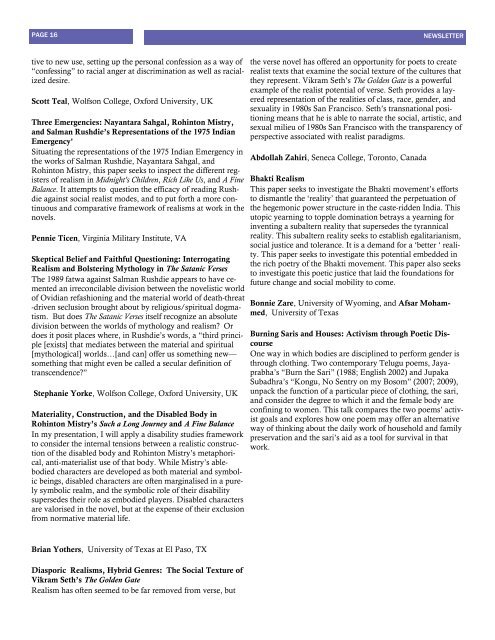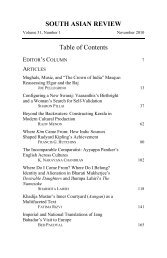2010 Winter Newsletter - South Asian Literary Association
2010 Winter Newsletter - South Asian Literary Association
2010 Winter Newsletter - South Asian Literary Association
You also want an ePaper? Increase the reach of your titles
YUMPU automatically turns print PDFs into web optimized ePapers that Google loves.
PAGE 16 NEWSLETTER<br />
tive to new use, setting up the personal confession as a way of<br />
“confessing” to racial anger at discrimination as well as racialized<br />
desire.<br />
Scott Teal, Wolfson College, Oxford University, UK<br />
Three Emergencies: Nayantara Sahgal, Rohinton Mistry,<br />
and Salman Rushdie’s Representations of the 1975 Indian<br />
Emergency'<br />
Situating the representations of the 1975 Indian Emergency in<br />
the works of Salman Rushdie, Nayantara Sahgal, and<br />
Rohinton Mistry, this paper seeks to inspect the different registers<br />
of realism in Midnight's Children, Rich Like Us, and A Fine<br />
Balance. It attempts to question the efficacy of reading Rushdie<br />
against social realist modes, and to put forth a more continuous<br />
and comparative framework of realisms at work in the<br />
novels.<br />
Pennie Ticen, Virginia Military Institute, VA<br />
Skeptical Belief and Faithful Questioning: Interrogating<br />
Realism and Bolstering Mythology in The Satanic Verses<br />
The 1989 fatwa against Salman Rushdie appears to have cemented<br />
an irreconcilable division between the novelistic world<br />
of Ovidian refashioning and the material world of death-threat<br />
-driven seclusion brought about by religious/spiritual dogmatism.<br />
But does The Satanic Verses itself recognize an absolute<br />
division between the worlds of mythology and realism? Or<br />
does it posit places where, in Rushdie’s words, a “third principle<br />
[exists] that mediates between the material and spiritual<br />
[mythological] worlds…[and can] offer us something new—<br />
something that might even be called a secular definition of<br />
transcendence?”<br />
Stephanie Yorke, Wolfson College, Oxford University, UK<br />
Materiality, Construction, and the Disabled Body in<br />
Rohinton Mistry’s Such a Long Journey and A Fine Balance<br />
In my presentation, I will apply a disability studies framework<br />
to consider the internal tensions between a realistic construction<br />
of the disabled body and Rohinton Mistry’s metaphorical,<br />
anti-materialist use of that body. While Mistry’s ablebodied<br />
characters are developed as both material and symbolic<br />
beings, disabled characters are often marginalised in a purely<br />
symbolic realm, and the symbolic role of their disability<br />
supersedes their role as embodied players. Disabled characters<br />
are valorised in the novel, but at the expense of their exclusion<br />
from normative material life.<br />
Brian Yothers, University of Texas at El Paso, TX<br />
Diasporic Realisms, Hybrid Genres: The Social Texture of<br />
Vikram Seth’s The Golden Gate<br />
Realism has often seemed to be far removed from verse, but<br />
the verse novel has offered an opportunity for poets to create<br />
realist texts that examine the social texture of the cultures that<br />
they represent. Vikram Seth’s The Golden Gate is a powerful<br />
example of the realist potential of verse. Seth provides a layered<br />
representation of the realities of class, race, gender, and<br />
sexuality in 1980s San Francisco. Seth’s transnational positioning<br />
means that he is able to narrate the social, artistic, and<br />
sexual milieu of 1980s San Francisco with the transparency of<br />
perspective associated with realist paradigms.<br />
Abdollah Zahiri, Seneca College, Toronto, Canada<br />
Bhakti Realism<br />
This paper seeks to investigate the Bhakti movement’s efforts<br />
to dismantle the ‘reality’ that guaranteed the perpetuation of<br />
the hegemonic power structure in the caste-ridden India. This<br />
utopic yearning to topple domination betrays a yearning for<br />
inventing a subaltern reality that supersedes the tyrannical<br />
reality. This subaltern reality seeks to establish egalitarianism,<br />
social justice and tolerance. It is a demand for a ‘better ‘ reality.<br />
This paper seeks to investigate this potential embedded in<br />
the rich poetry of the Bhakti movement. This paper also seeks<br />
to investigate this poetic justice that laid the foundations for<br />
future change and social mobility to come.<br />
Bonnie Zare, University of Wyoming, and Afsar Mohammed,<br />
University of Texas<br />
Burning Saris and Houses: Activism through Poetic Discourse<br />
One way in which bodies are disciplined to perform gender is<br />
through clothing. Two contemporary Telugu poems, Jayaprabha’s<br />
“Burn the Sari” (1988; English 2002) and Jupaka<br />
Subadhra’s “Kongu, No Sentry on my Bosom” (2007; 2009),<br />
unpack the function of a particular piece of clothing, the sari,<br />
and consider the degree to which it and the female body are<br />
confining to women. This talk compares the two poems’ activist<br />
goals and explores how one poem may offer an alternative<br />
way of thinking about the daily work of household and family<br />
preservation and the sari’s aid as a tool for survival in that<br />
work.



